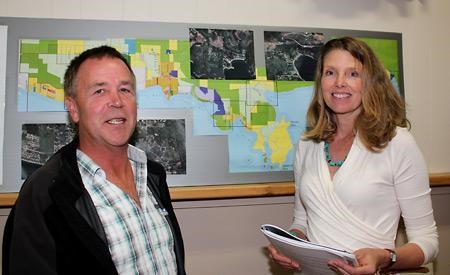Residents south of Powell River had an opportunity to learn more about Powell River Regional District’s draft OCP (official community plan) for Area C at a public meeting on October 10.
Laura Roddan, planner, gave an overview of the draft plan then answered questions from the approximately 30 people who attended the meeting. She explained the document builds on work that took place during the review of the southern regional district OCP between 2008 and 2011. “The process kind of went sideways,” she said.
Additionally, there were changes in the regional district’s administration, including in the planning department, after which staff examined the process and analyzed why it went sideways, Roddan explained. Subsequently, there was a recommendation to develop separate OCPs for areas B and C, which is typical for most regional districts in the province, she added.
New to the draft Area C OCP are development permit areas, for riparian areas and hazard areas, mainly coastal bluff areas, Roddan said. “In general, an OCP is a non-regulatory document,” she said. “It provides a vision, it provides policies. Decisions that the board makes need to be consistent with those policies.” The exception is development permit areas, Roddan added.
A zoning bylaw is a completely different tool from an OCP, Roddan also said. “There might be an interest in Area C among property owners to have a zoning bylaw at some point in the future, but the OCP is a completely separate document, a separate tool and it doesn’t speak to zoning,” she said. A zoning bylaw would make land use designations in the OCP specific zones and there would be regulations for development in those zones, she added.
Federal and provincial regulations guide much of what happens on the land base, Roddan said. She pointed out the total land area for Area C is 691 square kilometres and only 52 square kilometres is private property, or 7.5 per cent. “Local government has no authority over provincial Crown land,” she said. “The official community plan is for the whole of Area C, but our only real direct influence is over that 7.5 per cent of land that’s developed, mainly along the coastal strip and along the highway.”
In the existing OCP for the southern region, there is a commitment to recognize all existing uses in future land use bylaws, Roddan said. “We took that policy and applied it,” she said. “The land use designations are largely based on what’s actually out there on the land.”
A good reason to take that approach was to encourage economic development, Roddan said, pointing out that the area’s population was both decreasing and aging. “Many of the changes since 1989 are businesses that have set up, home-based businesses that grew into larger businesses that are employing people,” she said.
However, during the discussion period, many people had concerns about the lack of regulation in the area and spoke to how that policy has created conflict. They asked questions such as what is going to trigger a zoning bylaw, how is a home-based business defined and why areas listed in the sensitive ecosystem inventory were removed from development permit areas in the OCP. Some people who were involved in focus groups for the southern regional district OCP review pointed out their input had been ignored.
The regional district is holding another public meeting about the Area C draft OCP from 6 to 9 pm tonight, Wednesday, October 24 at Lang Bay Community Hall.



